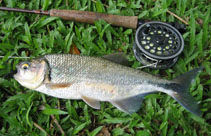| Family: |
Bryconidae ("Brycon characins"), subfamily: Bryconinae |
| Max. size: |
26.5 cm SL (male/unsexed); max.weight: 2,273.0 g |
| Environment: |
benthopelagic; freshwater |
| Distribution: |
Central America: Chiriquí del Tire and Chagres River basins, Pacific and Atlantic slopes of Panama; Quepos, Pacific slope of Costa Rica. |
| Diagnosis: |
Body color silver; gray green dorsally; silvery white ventrally. A thin black bar behind the operculum; a rhomboidal black spot on its tail, the color continuing to the tip of the caudal rays (Ref. 36880). |
| Biology: |
Inhabits streams and rivers of moderate to high current velocity in 10-640 meters elevation. Swims upstream in search of small tributaries in which to breed; lays eggs in excavated nest in the sandy bottom of creeks. Omnivorous, feeds on fruit, flowers, seeds, insects, annelids, crustaceans, and small fishes (Ref. 36880). Popular fish among sport anglers (Lopez-Pinto, pers. comm.). Maximum length reported to reach 40 cm TL (Ref. 36880). |
| IUCN Red List Status: |
Least Concern (LC); Date assessed: 04 April 2019 Ref. (130435)
|
| Threat to humans: |
harmless |
Source and more info: www.fishbase.org. For personal, classroom, and other internal use only. Not for publication.

